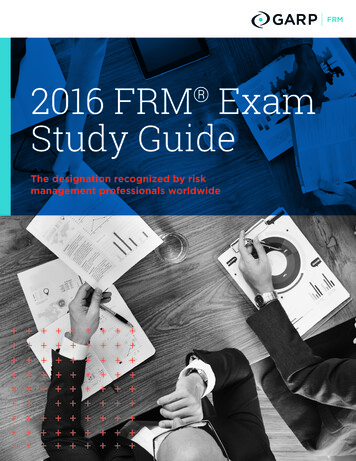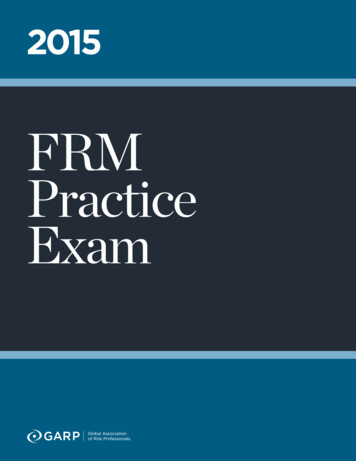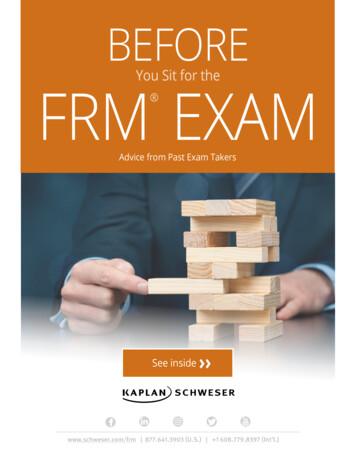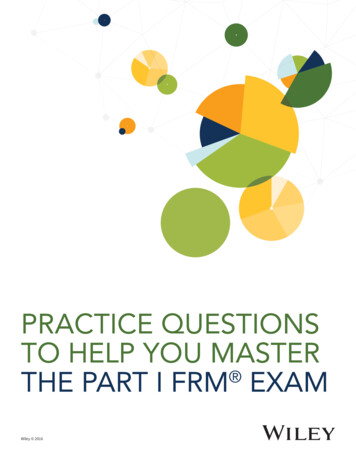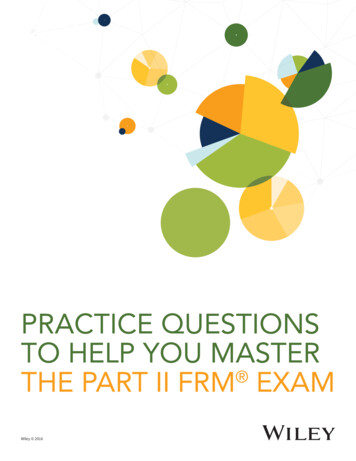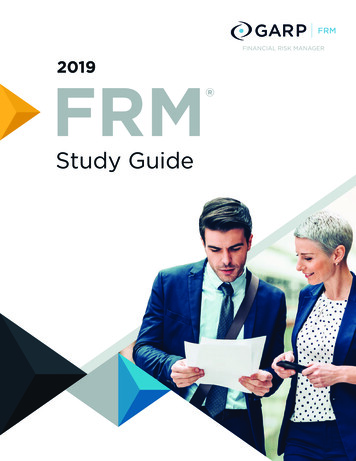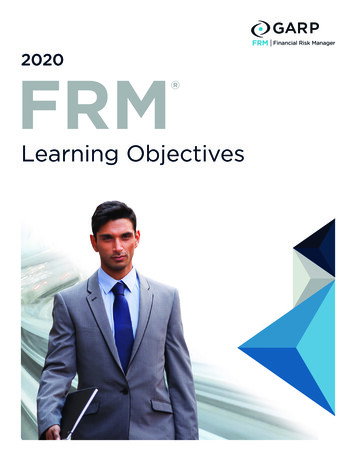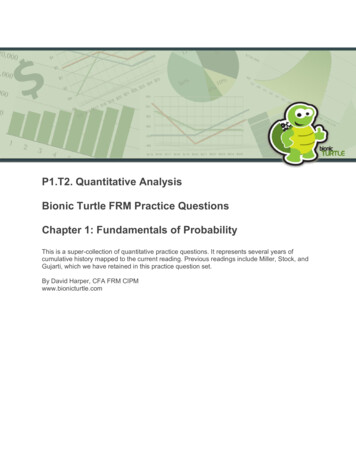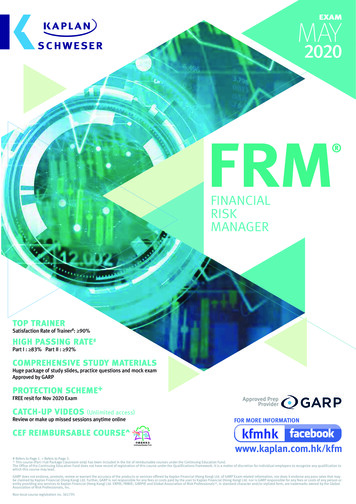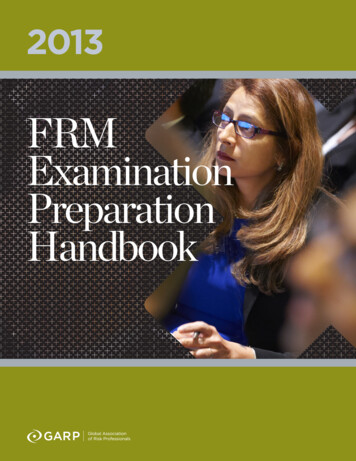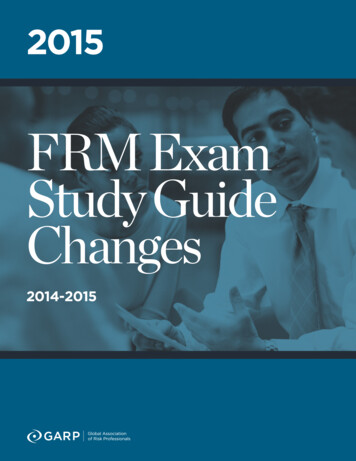
Transcription
2015FRM ExamStudy GuideChanges2014-2015
FRM Exam Study Guide Changes 2014-2015FRM EXAM PART I CHANGESFOUNDATIONS OF RISK MANAGEMENTAdditions1.Michel Crouhy, Dan Galai, and Robert Mark, The Essentials of Risk Management, 2nd Edition(New York: McGraw-Hill, 2014).2. Chapter 1. Risk Management: A Helicopter View (Appendix 1.1. Typology of Risk Exposures) Chapter 2. Corporate Risk Management: A Primer Chapter 4. Corporate Governance and Risk ManagementJames Lam, Enterprise Risk Management: From Incentives to Controls, 2nd Edition(Hoboken, NJ: John Wiley & Sons, 2014). 3.Chapter 4. What is ERM?“Implementing Robust Risk Appetite Frameworks to Strengthen Financial Institutions,” Institute of InternationalFinance, June 2011.4.John Hull, Risk Management and Financial Institutions, 3rd Edition (New York: John Wiley & Sons, 2012). 5.Chapter 6. The Credit Crisis of 2007“Principles for Effective Data Aggregation and Risk Reporting,” (Basel Committee on Banking SupervisionPublication, January 2013).Deletions1.“Risk Taking: A Corporate Governance Perspective,” (International Finance Corporation, World Bank Group, June 2012).2.“Understanding and Communicating Risk Appetite,” (COSO, written by Dr. Larry Rittenberg and Frank Martens,January 2012).Updates1.Edwin J. Elton, Martin J. Gruber, Stephen J. Brown and William N. Goetzmann, Modern Portfolio Theory andInvestment Analysis, 9th Edition (Hoboken, NJ: John Wiley & Sons, 2014). Now using 9th Edition, 2014. 2.Chapter 13. The Standard Capital Asset Pricing ModelZvi Bodie, Alex Kane, and Alan J. Marcus, Investments, 10th Edition (New York: McGraw-Hill, 2013).Now using 10th Edition, 2013. Chapter 10. Arbitrage Pricing Theory and Multifactor Models of Risk and ReturnKnowledge Point ChangesThe knowledge points are unchanged but have been reordered as follows: Basic risk types, measurement and management tools Creating value with risk management The role of risk management in corporate governance Enterprise Risk Management (ERM) Financial disasters and risk management failures The Capital Asset Pricing Model (CAPM) Risk-adjusted performance measurement Multi-factor models Information risk and data quality management Ethics and the GARP Code of Conduct 2015 Global Association of Risk Professionals. All rights reserved.1
FRM Exam Study Guide Changes 2014-2015QUANTITATIVE ANALYSISAdditions1.John Hull, Risk Management and Financial Institutions, 3rd Edition (Boston: Pearson Prentice Hall, 2012). 2.Chapter 11. Correlation and CopulasFrancis X. Diebold, Elements of Forecasting, 4th Edition (Mason, Ohio: Cengage Learning, 2006). Chapter 5. Modeling and Forecasting Trend (Section 5.4 only—Selecting Forecasting Models Using the Akaike andSchwarz Criteria) Chapter 7. Characterizing Cycles Chapter 8. Modeling Cycles: MA, AR, and ARMA ModelsDeletionsNoneUpdates1.Michael Miller, Mathematics and Statistics for Financial Risk Management, 2nd Edition(Hoboken, NJ: John Wiley & Sons, 2013). Now using 2nd Edition, 2013. 2.Chapter 2. Probabilities Chapter 3. Basic Statistics Chapter 4. Distributions Chapter 6. Bayesian Analysis (New Reading) (Pages 113-124 only) Chapter 7. Hypothesis Testing and Confidence IntervalsJohn Hull, Options, Futures, and Other Derivatives, 9th Edition (New York: Pearson Prentice Hall, 2014).Now using 9th Edition, 2014. Chapter 23. Estimating Volatilities and Correlations for Risk ManagementKnowledge Point ChangesKnowledge points have been reordered and modified as follows: Discrete and continuous probability distributions Estimating the parameters of distributions Population and sample statistics Bayesian analysis (New—Reflects added reading) Statistical inference and hypothesis testing Correlations and copulas (New—Reflects added reading) Estimating correlation and volatility using EWMA and GARCH models Volatility term structures Linear regression with single and multiple regressors (Subpoints have been deleted) Time series analysis Simulation methods2 2015 Global Association of Risk Professionals. All rights reserved.
FRM Exam Study Guide Changes 2014-2015FINANCIAL MARKETS AND PRODUCTSAdditions1.2.John Hull, Options, Futures, and Other Derivatives, 9th Edition. Chapter 10. Mechanics of Options Markets Chapter 26. Exotic OptionsBruce Tuckman, Angel Serrat, Fixed Income Securities: Tools for Today’s Markets, 3rd Edition (New York: Wiley, 2011) Chapter 20. Mortgages and Mortgage-Backed SecuritiesDeletions1.Helyette Geman, Commodities and Commodity Derivatives: Modeling and Pricing for Agriculturals, Metals and Energy(West Sussex, England: John Wiley & Sons, 2005). Chapter 1. Fundamentals of Commodity Spot and Futures Markets: Instruments, Exchanges and StrategiesUpdates1.2.John Hull, Options, Futures, and Other Derivatives, 9th Edition. Now using 9th Edition, 2014. Chapter 1. Introduction Chapter 2. Mechanics of Futures Markets Chapter 3. Hedging Strategies Using Futures Chapter 4. Interest Rates Chapter 5. Determination of Forward and Futures Prices Chapter 6. Interest Rate Futures Chapter 7. Swaps Chapter 11. Properties of Stock Options Chapter 12. Trading Strategies Involving OptionsAnthony Saunders and Marcia Millon Cornett, Financial Institutions Management: A Risk Management Approach,8th Edition (New York: McGraw-Hill, 2014). Now using 8th Edition, 2014. Chapter 13. Foreign Exchange RiskKnowledge Point ChangesKnowledge points have been consolidated and modified as follows: Structure and mechanics of OTC and exchange markets Structure, mechanics, and valuation of forwards, futures, swaps and options (Subpoints consolidated) Hedging with derivatives Interest rates and measures of interest rate sensitivity Foreign exchange risk Corporate bonds Mortgage-backed securities (New—Moved from Part II—Market Risk Measurement) Rating agencies 2015 Global Association of Risk Professionals. All rights reserved.3
FRM Exam Study Guide Changes 2014-2015VALUATION AND RISK MODELSAdditions1.Gerhard Schroeck, Risk Management and Value Creation in Financial Institutions (New York: Wiley, 2002). Chapter 5. Capital Structure in Banks (Pages 170-186 only).Deletions1.Michael Ong, Internal Credit Risk Models: Capital Allocation and Performance Measurement(London: Risk Books, 2003).2. Chapter 4. Loan Portfolios and Expected Loss Chapter 5. Unexpected LossBruce Tuckman, Fixed Income Securities, 3rd Edition (Hoboken, NJ: John Wiley & Sons, 2011). Chapter 6. Empirical Approaches to Risk Metrics and Hedges (Moved to Part II—Market Risk)Updates1.John Hull, Options, Futures, and Other Derivatives, 9th Edition. Now using 9th Edition, 2014 Chapter 13. Binomial Trees Chapter 15. The Black-Scholes-Merton Model Chapter 19. The Greek LettersKnowledge Point ChangesKnowledge points have been consolidated and expanded and reordered as follows: Value-at-Risk (VaR) (Subpoints deleted) Expected shortfall (New Knowledge point) Stress testing and scenario analysis Option valuation (Subpoints deleted) Fixed income valuation (Subpoints deleted) Country and sovereign risk models and management External and internal credit ratings Expected and unexpected losses Operational risk4 2015 Global Association of Risk Professionals. All rights reserved.
FRM Exam Study Guide Changes 2014-2015FRM EXAM PART II CHANGESMARKET RISK MEASUREMENT AND MANAGEMENTAdditions1.2.Gunter Meissner, Correlation Risk Modeling and Management (New York: Wiley, 2014). Chapter 1. Some Correlation Basics: Properties, Motivation, Terminology Chapter 2. Empirical Properties of Correlation: How Do Correlations Behave in the Real World? Chapter 3. Statistical Correlation Models—Can We Apply Them to Finance? Chapter 4. Financial Correlation Modeling—Bottom-Up Approaches (Sections 4.3.0 (intro), 4.3.1, and 4.3.2 only)Bruce Tuckman, Fixed Income Securities, 3rd Edition (Hoboken, NJ: John Wiley & Sons, 2011). 3.Chapter 6. Empirical Approaches to Risk Metrics and Hedges (Moved from Part I—Valuation)John Hull, Options, Futures, and Other Derivatives, 9th Edition. Chapter 9. OIS Discounting, Credit Issues, and Funding CostsDeletions1.Kevin Dowd, Measuring Market Risk, 2nd Edition (West Sussex, England: John Wiley & Sons, 2005). 2.Chapter 5. Appendix—Modeling Dependence: Correlations and CopulasJacob Boudoukh, Matthew Richardson and Robert F. Whitelaw, “The Best of Both Worlds: A Hybrid Approach toCalculating Value at Risk,” Stern School of Business, NYU.3.John Hull and Alan White, “Incorporating Volatility Updating into the Historical Simulation Method for Value at Risk,Journal of Risk, October 1998.4.John Hull and Alan White, “LIBOR vs. OIS: The Derivatives Discounting Dilemma,” April 2013. Forthcoming in theJournal of Investment Management.5.John Hull, Options, Futures, and Other Derivatives, 8th Edition. 6. 7.Chapter 25. Exotic OptionsPietro Veronesi, Fixed Income Securities (Hoboken, NJ: John Wiley & Sons, 2010).Chapter 8. Basics of Residential Mortgage Backed SecuritiesFrank Fabozzi, Anand Bhattacharya, William Berliner, Mortgage-Backed Securities, 3rd Edition(Hoboken, NJ: John Wiley & Sons, 2011). Chapter 1. Overview of Mortgages and the Consumer Mortgage Market Chapter 2. Overview of the Mortgage-Backed Securities Market Chapter 10. Techniques for Valuing MBSUpdates1.John Hull, Options, Futures, and Other Derivatives, 8th Edition. Now using 9th Edition, 2014. Chapter 20. Volatility SmilesKnowledge Point Changes “Exotic Options” has been deleted. “Mortgages and Mortgage-backed securities (MBS)” along with the subpoint of “Structure, markets and valuation”have been consolidated and moved to FRM Exam Part I. 2015 Global Association of Risk Professionals. All rights reserved.5
FRM Exam Study Guide Changes 2014-2015CREDIT RISK MEASUREMENT AND MANAGEMENTThe changes in this section reflect an update to the 2nd Edition of the Jon Gregory book, as well as the chapter on wrongway risk being re-added to the n Malz, Financial Risk Management: Models, History, and Institutions (Hoboken, NJ: John Wiley & Sons, 2011).Chapter 8. Only Sections 8.1, 8.2 and 8.3 will be covered.Knowledge Point ChangesThe knowledge points have been consolidated to the following: Credit analysis Default risk: Quantitative methodologies (Risk neutral valuations has been deleted) Expected and unexpected loss Credit VaR Counterparty risk (Subpoints deleted) Credit derivatives (Subpoints deleted) Structured finance and securitization (Subpoints deleted)6 2015 Global Association of Risk Professionals. All rights reserved.
FRM Exam Study Guide Changes 2014-2015OPERATIONAL AND INTEGRATED RISK MANAGEMENTAdditions1.Bruce Tuckman, Angel Serrat, Fixed Income Securities: Tools for Today’s Markets, 3rd Edition (New York: Wiley, 2011). 2.Chapter 12. Repurchase Agreements and Financing“Capital Planning at Large Bank Holding Companies: Supervisory Expectations and Range of Current Practice,”Board of Governors of the Federal Reserve System, August 2013 (Moved from 2014 Current Issue readings).3.John Hull, Risk Management and Financial Institutions, 3rd Edition (New York: John Wiley & Sons, 2012). Chapter 12. Basel I, Basel II and Solvency II Chapter 13. Basel 2.5, Basel III, and Dodd-FrankDeletions1.Mo Chaudhury, “A Review of the Key Issues in Operational Risk Capital Modeling,” The Journal of Operational Risk,Volume 5/Number 3, Fall 2010: pp. 37-66.2.Eric Cope, Giulio Mignola, Gianluca Antonini and Roberto Ugoccioni, “Challenges and Pitfalls in MeasuringOperational Risk from Loss Data,” The Journal of Operational Risk, Volume 4/Number 4, Winter 2009/10: pp. 3-27.3.“Principles for Effective Data Aggregation and Risk Reporting,” (Basel Committee on Banking SupervisionPublication, January 2013).4.Nadine Gatzert, Hannah Wesker, “A Comparative Assessment of Basel II/III and Solvency II,” Working Paper,Friedrich-Alexander-University of Erlangen-Nuremberg, Version: October 2011.*UpdatesNoneKnowledge Point ChangesThe knowledge points have been consolidated and augmented as follows: Principles for sound operational risk management (New) Enterprise Risk Management (ERM) Modeling operational loss distributions (Consolidation of Operational loss data and subpoints) Liquidity risk (including repurchase agreements and funding risks) Model risk Risk appetite frameworks Risk-adjusted return on capital (RAROC) Economic capital frameworks and capital allocation (Expansion of Economic Capital knowledge point) Stress testing banks (New) Evaluating the performance of risk management systems Failure mechanics of dealer banks Regulation and the Basel Accords (Subpoints deleted) 2015 Global Association of Risk Professionals. All rights reserved.7
FRM Exam Study Guide Changes 2014-2015RISK MANAGEMENT AND INVESTMENT MANAGEMENTAdditions1.Andrew Ang, Asset Management: A Systematic Approach to Factor Investing(New York: Oxford University Press, 2014). Chapter 13. Illiquid Assets (Excluding Section 13.5—Portfolio Choice with Illiquid Assets)Deletions1.Andrew W. Lo, “Risk Management for Hedge Funds: Introduction and Overview,” Financial Analysts Journal, Vol. 57,No. 6 (November-December 2001), pp. 16-33.*UpdatesNoneKnowledge Point ChangesAll subpoints under “Hedge Funds” have been eliminated.8 2015 Global Association of Risk Professionals. All rights reserved.
FRM Exam Study Guide Changes 2014-2015CURRENT ISSUES IN FINANCIAL MARKETSAdditions1.Roe, M. (2013) Clearinghouse Overconfidence. California Law Review, 101 (6), pp. 1641-1703.*2.O’Hara, M. (2014). High-Frequency Trading and Its Impact on Markets. Financial Analysts Journal, 70, 3. pp. 18-27.*3.Clark, C. (2010). Controlling Risk in a Lightning-Speed Trading Environment.*4.Clark, C. (2011). How Do Exchanges Control the Risk of High Speed Trading?*5.Clark, C. and Ranjan, R. (2012). How Do Proprietary Trading Firms Control the Risks of High Speed Trading?*6.“Report on Cyber Security in the Banking Sector,” New York State Department of Financial Services. May 2014.*7.“Framework for Improving Critical Infras
FRM EXAM PART I CHANGES FOUNDATIONS OF RISK MANAGEMENT Additions 1. Michel Crouhy, Dan Galai, and Robert Mark, The Essentials of Risk Management, 2nd Edition (New York: McGraw-Hill, 2014). Chapter 1. Risk Management: A Helicopter View (Appendix 1.1. Typology of Risk Exposures) Chapter 2. Corporate Risk Management: A Primer Chapter 4. Corporate Governance

